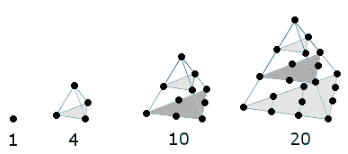
| Base | Number of Dots |
| Triangle | \[\frac{1}{6}n(n+1)(n+2)\] |
| Square | \[\frac{1}{6}n(n+1)(2n+1)\] |
| Pentagon | \[\frac{1}{2}n^2(n+1)\] |
| Hexagon | \[\frac{1}{6}n(n+1)(4n-1)\] |
| Heptagon | \[\frac{1}{6}n(n+1)(5n-2)\] |
| Octagon | \[\frac{1}{2}n(n+1)(2n-1)\] |
| n - gon | \[\frac{1}{6}n(n+1)(n(r-2)-(r-5))\] |
